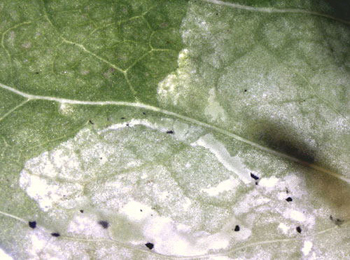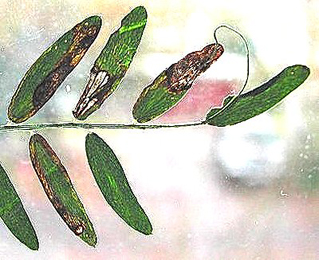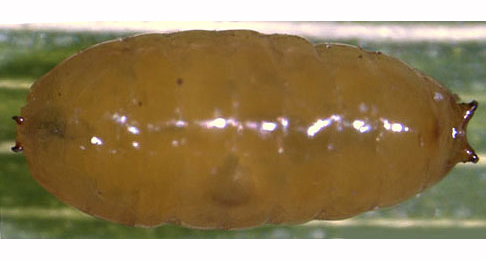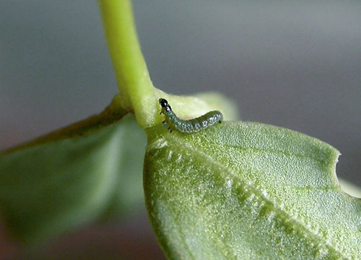|
||||||
|
VICIA. Vetches. [Fabaceae] |
|
|
Thirty-five species of Vicia are recorded in Britain. Eleven of these are native species. These include the native Tufted Vetch (V. cracca), Hairy Tare (V. hirsuta), Common Vetch (V. sativa), Bush Vetch (V. sepium), Wood Vetch (V. sylvatica) and Smooth Tare (V. tetraspermum) and the introduced Purple Vetch (V. benghalensis), Broad Bean (V. faba), Narbonne Vetch (V. narbonensis), Fine-leaved Vetch (V. tenifolia) and Fodder Vetch (V. villosa). The BSBI provide a downloadable plant crib for Vicia with mature fruits. Twenty-one British miners are recorded on Vicia. The polyphagous agromyzid Liriomyza huidobrensis has been recorded in quarantine in Britain (Pitkin & Plant in British leafminers). See also Liriomyza species in Glasshouses and/or Quarantine Interceptions. A key to the European miners recorded on Vicia is provided in Bladmineerders van Europa. |
 Vetch Vicia sp. |
Key for the identification of the known mines of British |
||
Note: Diptera larvae may live in a corridor mine, a corridor-blotch mine, or a blotch mine, but never in a case, a rolled or folded leaf, a tentiform mine or sandwiched between two more or less circular leaf sections in later instars. Pupation never in a cocoon. All mining Diptera larvae are leg-less maggots without a head capsule (see examples). They never have thoracic or abdominal legs. They do not have chewing mouthparts, although they do have a characteristic cephalo-pharyngeal skeleton (see examples), usually visible internally through the body wall. The larvae lie on their sides within the mine and use their pick-like mouthparts to feed on plant tissue. In some corridor miners frass may lie in two rows on alternate sides of the mine. In order to vacate the mine the fully grown larva cuts an exit slit, which is usually semi-circular (see Liriomyza huidobrensis video). The pupa is formed within the hardened last larval skin or puparium and as a result sheaths enclosing head appendages, wings and legs are not visible externally (see examples). See Key to non-Diptera. |
||
1a > Stem miner |
||
1b > Leaf-miner |
||
2a > Stem miner: A long external whitish stem mine, feeding downwards from a leaf stalk or part of the upper stem. Pupation external (Spencer, 1972b: 41). Puparium yellowish |
||
|
||
Agromyza marionae Griffiths, 1963 [Diptera: Agromyzidae]. |
||
2b > Stem miner: An external stem mine. Pupation in the stem, near or even below ground level, with the anterior spiracles projecting through the epidermis (Spencer, 1976: 72-3). |
||
|
||
Ophiomyia orbiculata (Hendel, 1931) [Diptera: Agromyzidae]. |
||
3a > Leaf-miner: A distinctive mine primarily above mid-rib, with irregular short lateral offshoots into leaf blade. Pupation external (Spencer, 1972: 51 (fig. 172), 55; Spencer, 1976: 270, 271 (fig. 486)). Branched, whitish, upper-surface corridor; main axis overlying the midrib; side branches overlying the main lateral veins. (In Campanula and Phyteuma the mine is much less branched, sometimes nothing more than a corridor on top of the midrib). Frass in rather long strings. Usually the mines begins as a long and narrow, shallow, tortuous lower-surface corridor that ends upon the midrib but otherwise is not associated with the leaf venation. Often this initial corridor is filled with callus, and then even less conspicuous. Pupation outside the mine. A linear mine on the upper surface, usually following the midrib and showing side branches along the veins. The frass is in strings. |
||
|
||
|
||
Liriomyza strigata (Meigen, 1830) [Diptera: Agromyzidae]. |
||
3b > Leaf-miner: Mine not primarily associated with mid-rib. |
||
4a > Leaf miner: An initially lower-surface linear leaf-mine, which later develops into large whitish blotch and appears pale and mottled from above, due to the variable depth of larval feeding. Less frequently feeding in upper surface or stem (Spencer, 1972b: 37, fig. 112); Spencer, 1976: 118). The mine starts as a superficial lower-surface corridor. After its first moult the larva starts making a blotch, often close to the base of the leaflet. The blotch in principle is lower-surface, but may be interparenchymatous for some part. Moreover, in places the larva feeds from the palissade parenchyma. Seen from above the leaf appears mottled. The overall result is that the mine, despite its considerable size, is hard to find. The easiest way is to hold the leaves against the light: the large larvae than are conspicuous. Frass in coarse grains, both in the corridor and in the blotch; in the corridor they are widely spaced. Pupation outside the mine. Puparium reddish |
||
 Part of mine of Agromyza lathyri on Pisum sativum Image: © Willem Ellis (Bladmineerders van Europa) |
||
|
||
Agromyza lathyri Hendel, 1923 [Diptera: Agromyzidae]. |
||
4b > Leaf-miner: Mine beginning linear, later becoming a primary blotch (Spencer, 1972b: 42). Large blotch, preceded by a corridor that meticulously follows the leaf margin. Blotch clearly upper-surface, nowhere mined out deeper than the corridor, and equally transparent. The blotch is not oriented on the midrib. Frass in the corridor in short streaks along the sides, in the blotch as small grains that partly may be deliquescent. Pupation outside the mine. |
||
|
||
Agromyza bicophaga Hering, 1925 [Diptera: Agromyzidae]. |
||
4c > Leaf-miner: A primary blotch-mine, which entirely fills a leaf and usually shows some reddish colouration; frass in distinct grains (Spencer, 1972b: 41). Oviposition in the tip of a leaflet, Primary blotch without a preceding corridor; distal half mostly a red colouration. The blotch is upper-surface with a few full depth patches, making it look spotty in transparency. Frass in groups of grains. Pupation outside the mine. |
||
|
||
Agromyza felleri Hering, 1941 [Diptera: Agromyzidae]. |
||
4d > Leaf-miner: Larva producing a short narrow linear mine not associated with the margin, which then develops into a conspicuous white blotch centred on the mid-rib. At the end of feeding the larva lies for one or two days along the mid-rib. Pupation external (Spencer, 1972b: 37 (fig. 114b); Spencer, 1976: 126, fig. 213A). Broad and short hook-like upper-surface corridor, ending in a little blotch in the centre of a leaflet. The blotch is upper-surface as well, but has some deep spots, giving the mine a mottled appearance when hold against the light. Frass in the blotch in a few large lumps. Pupation outside the mine. A short, broad gallery leading to a conspicuous, roundish white blotch in the centre of the leaf. The blotch is upper surface with full depth spots - comprising of large clumps of frass. Puparium reddish |
||
|
||
Agromyza nana Meigen, 1830 [Diptera: Agromyzidae]. |
||
4e > Leaf-miner: Mine initially linear, adjoining margin of leaf, later developing into a blotch, always on the mid-rib (Spencer, 1976: 145, fig. 265). Blotch, preceded by a corridor that closely follows the leaf margin. The blotch is mined much deeper (and therefore more transparent) than the corridor. The blotch is precisely positioned over te midrib of the leaflet. Frass very sparingly in the corridor, in the blotch as a few large lumps. Pupation outside the mine. Forms a blotch over the mid-rib without an initial gallery mine. Frass dispersed. |
||
 Mines
of Agromyza vicifoliae on Vicia |
||
|
||
Agromyza vicifoliae Hering, 1932 [Diptera: Agromyzidae]. |
||
4f > Leaf-miner: Oviposition in the tip of a leaflet; this causes an intensive red colouring of the distal part of the leaflet. From there a primary blotch develops, that in the end occupies almost the entire leaflet. At first the mine is upper-surface, but gradually deeper parts of the mine are eaten away, leading to a very transparent mine. Frass fine-grained, quickly deliquescent. Pupation outside the mine. |
||
|
||
Agromyza viciae Kaltenbach, 1872 [Diptera: Agromyzidae] |
||
4g > Leaf-miner: Mine linear, whitish, both upper and lower surface. Pupation internal, at the end of the mine with the anterior spiracles projecting through the epidermis (Spencer, 1976: 433). Upper-surface, less often lower-surface corridor. Frass in isolated grains. Pupation within the mine, usually in a lower-surface puparial chamber. A long whitish upper surface corridor, which eventually goes lower surface. |
||
|
||
Chromatomyia horticola (Goureau, 1851) [Diptera: Agromyzidae]. |
||
4h > Leaf-miner: An upper surface linear mine with frass in conspicuous greenish strips, largely alternating at each side of the channel. Puparium yellow |
||
 Liriomyza congesta puparium Image: © Willem Ellis (Bladmineerders van Europa) |
||
|
||
Liriomyza congesta (Becker, 1903) [Diptera: Agromyzidae]. |
||
4i > Leaf-miner: A long linear mine, normally starting on lower surface, frass in black strips alternately at sides of mine (Spencer, 1972b: 58). Long whitish corridor, almost always lower-surface at first, then becoming largely or totally upper-surface. Because lower- and upper-surface tracts often cross the leaf looks distinctly mottled whe held against the light. The final part of the corridor is generally upper-surface. The corridor often follows a thick vein for a considerable distance. Frass in alternating thread fragments. Pupation outside the mine. |
||
|
||
Liriomyza pisivora Hering, 1957 [Diptera: Agromyzidae]. |
||
4j > Leaf-miner: A short, irregular, linear upper surface mine on any part of the leaf. Also recorded from young pods (Bland, 1997a). Long corridor mine. As a rule the first part of the mine is lower-surface, the later part upper-surface. Often the loops are so dense that a secondary blotch is the result. Because upper- and lower-surface corridor segments often cross, the mine obtains a strange array of transparant patches. There is no association with the midrib. Frass in strings and thread fragments. Pupation outside the mine; exit slit in upper epidermis. Mine not associated with the veins or midrib of the leaf (It is this character which enables distinction from another Agromyzid pest species - Liriomyza huidobriensis). The larvae may leave one leaf (if not large enough) and enter another leaf, via the petiole). It exits the leaf to pupate through a semi-circular slit in the upper surface of the leaf. |
||
|
||
Liriomyza bryoniae (Kaltenbach, 1858) [Diptera: Agromyzidae]. |
||
4k > Leaf-miner: A narrow linear mine adjoining the leaf margin in the first instar, which later develops into an irregular blotch with conspicuous lumps of greenish frass (Spencer, 1976: 302). The first instar larva makes a narrow upper-surface corridor along the leaf margin. After it has moulted it begins a large upper-surface blotch. Frass in conspicuous green lumps, that can run out irregularly. Pupation outside the mine. Forms a narrow linear mine by the margin of the leaf which later develops into a blotch. The blotch has clumps of greenish frass. |
||
|
||
Phytoliriomyza variegata (Meigen, 1830) [Diptera: Agromyzidae]. |
||
|
Key for the identification of the known mines of British |
Note: The larvae of mining Coleoptera, Hymenoptera and Lepidoptera may live in a corridor mine, a corridor-blotch mine, a blotch mine, a case, a rolled or folded leaf, a tentiform mine or sandwiched between two more or less circular leaf sections in later instars. Larva may pupate in a silk cocoon. The larva may have six legs (although they may be reduced or absent), a head capsule and chewing mouthparts with opposable mandibles (see video of a gracillarid larva feeding). Larvae of Hymenoptera and Lepidoptera usually also have abdominal legs (see examples). Frass, if present, never in two rows. Unless feeding externally from within a case the larva usually vacates the mine by chewing an exit hole. Pupa with visible head appendages, wings and legs which lie in sheaths (see examples). |
| 1a > Leaf-miner and case-bearer: The larva lives outside the mine, protected by a case, and feeds on the underlying plant tissues via a hole cut in the epidermis. From that point it eats away as much leaf tissue as it can reach without fully entering the mine. Mine does not contain frass (Coleophora species) |
1b > Leaf-miner, but not a case-bearer: The larva lives mainly inside the mine. Mine usually contains frass. In later instars the larva may live sandwiched between two more or less circular sections cut from the leaf. |
2 > Leaf-miner and case-bearer: Larva in a huge (19 mm) shining black tubular silken case; mouth angle 60°. The end of the case is strongly rolled in (remnant of the youth case) and bears a small pallium.The final case is the largest of any coleophorid in the UK, being 19mm long. The anal end of this case incorporates the remains of the spiral first case and is hooded in a pallium. |
|
Coleophora vibicella (Hübner, 1813) [Lepidoptera: Coleophoridae]. |
3a> Leaf-miner: Small full depth blotch; older larvae free among spun leaves (Robbins, 1991a). |
|
Ancylis badiana (Denis & Schiffermmüller, 1775) [Lepidoptera: Tortricidae]. |
3b > Leaf-miner: The first generation initially forms an unmistakable leaf-mine on Anthyllis vulneraria, but the second generation feeds on the flowers. Feeding signs on other plants vary in appearance. Larvae can move between sewn leaves, and more than one larva may be found together. |
 Aproaerema anthyllidella larva, dorsal Image: © Steve Wullaert (Bladmineerders van Europa) |
|
Aproaerema anthyllidella (Hübner, 1813) [Lepidoptera: Gelechiidae]. |
3c > Leaf-miner: In the first instar the larva mines the leaves, forming short, irregular, blotch-like mines, but in later instars it lives externally, feeding in spun leaves and often twisting those of tender shoots. Larval head light-brown or yellowish brown, edged with black postero-laterally, ocellar area blackish; prothoracic plate black edged with whitish anteriorly; abdomen dull dark green; pinacula distinct, black, sometimes brownish but with black bases to setae; anal plate large, black (Bradley et al., 1973). Small, full depth mine without a definite shape; little frass. Some silk is deposited in the mine. The larva soon leaves the mine and continues feeding among spun leaves. |
|
Cnephasia incertana (Treitschke, 1835) [Lepidoptera: Tortricidae]. |
3d > Leaf-miner: A blotch mine is formed with a small area of browning of the leaf around the egg. Flat, upper-surface, oval blotch without a preceding gallery, with clear amounts of greenish frass. Sometimes more than one mine in a leaflet, that can merge. Pupation outside the mine. |
|
Cosmopterix schmidiella Frey, 1856 [Lepidoptera: Cosmopterigidae]. |
3e > Leaf-miner: Lower surface tentiform mine that occupies only part of a leaflet. In full grown leaves the mine is strongly inflated and is largely hidden by the leaf. Unlike other species the entire leaflet is not mined out. |
|
Phyllonorycter insignitella (Zeller, 1846) [Lepidoptera: Incurvariidae]. |
3f > Leaf-miner: The mine is underside, occupying the whole leaflet, which turns down at edges. Lower surface tentiform mine that occupies an entire leaflet; lower epidermis strongly folded. Fully developed mines are strongly inflated and the leaflet is so completely folded over the mine that the latter becomes practically invisible. In this stage the larva has consumed also all tissue in the roof of the mine, making the mine very conspicuous. |
|
Phyllonorycter nigrescentella (Logan, 1851) [Lepidoptera: Incurvariidae]. |
| Last updated 09-Jul-2020 Brian Pitkin | ||

